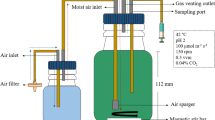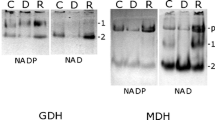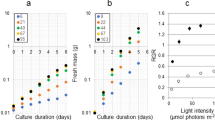Summary
Mass cultures ofChlorella stigmatophora were carried out in order to obtain maximum protein production and to study the chemical variations in function of the nutrient concentration. Cultures reached maximum cellular densities of 2.2·108 cells/ml, with a growth velocity between 0.49 and 0.55 doublings/day. Carbohydrate content in the stationary phase ranged between 2.23 and 2.74 pg/cell, RNA between 0.78 and 1.36 pg/cell and DNA between 0.013 and 0.016 pg/cell. The maximum value for chlorophylla was 0.13 pg/cell. Maximum protein content was obtained with a nutrient concentration of 16 mM of NaNO3, giving 4.85 pg/cell and a protein concentration of 0.7 g/l. The protein content can be manipulated by changes in the nutrient concentration, showing differences up to a 9.2-fold increase. This characteristic makesChlorella stigmatophora a suitable source of single cell protein.
Similar content being viewed by others
References
Bradford, M. 1976. A rapid and sensitive method for the quantitation of microgram quantities of protein utilizing the principle of protein dye-binding. Anal. Biochem. 72: 248–254.
Ciferri, O. 1983.Spirulina, the edible microorganism. Microbiol. Rev. 47(4): 551–578.
Fabregas, J. and C. Herrero. 1985. Marine microalgae as a potential source of single cell protein (SCP). Appl. Microbiol. Biotechnol. 23: 110–113.
Fabregas, J. and C. Herrero. 1986. Marine microalgae as a potential source of minerals in fish diets. Aquaculture 51: 237–243.
Fabregas, J., C. Herrero, B. Cabezas and J. Abalde. 1985. Mass culture and biochemical variability of the marine microalgaTetraselmis suecica (Kylin) Butch with high nutrient concentrations. Aquaculture 49: 231–244.
Fabregas, J., C. Herrero, B. Cabezas and J. Abalde. 1986. Biomass production and biochemical composition in mass cultures of the marine microalgaIsochrysis galbana Parke at varying nutrient concentration. Aquaculture 53: 101–113.
Farbregas, J., C. Herrero and M. Veiga. 1984. Effect of oil and dispersant on growth and chlorophylla content of the marine microalgaTetraselmis suecica. Appl. Environ. Microbiol. 47(2): 445–447.
Goldman, J.C. 1979. Outdoor algal mass cultures. I. Applications. Water Res. 13: 1–9.
Hitchcock, G.L. 1980. Diel variation in chlorophylla, carbohydrates and protein content of the marine diatomSkeletonema costatum. Mar. Biol. 57: 271–278.
Hwang, W.J., H.H. Wang and C.Y. Lii. 1980. Studies on some physicochemical properties of commercial cultivatedChlorella powder. In: Algae Biomass. Production and Use (Shelef, G. and C.J. Soeder, eds.), pp. 687–696, Elsevier North Holland Biomedical Press, Amsterdam.
Kharatyan, S.G. 1978. Microbes as food for humans. Annu. Rev. Microbiol. 32: 301–327.
Kochert, G. 1978a. Carbohydrate determination by the phenol-sulphuric acid method. In: Handbook of Phycological Methods. Physiological and Biochemical Methods (Hellebust, J.A. and J.S. Craigie, eds.), pp. 95–97, Cambridge University Press, London.
Kochert, G. 1978b. Quantitation of the macromolecular components of microalgae. In: Handbook of Phycological Methods. Physiological and Biochemical Methods (Hellebust, J.A. and J.S. Craigie, eds.), pp. 189–195, Cambridge University Press, London.
Kosmakova, V.E. and L.T. Prozumenshchicova. 1983. Growth and biochemical composition of the algaeDunaliella salina andPlatymonas viridis fed on organic and inorganic nitrogen. Biol. Morya 1: 42–46.
McLachlan, J. 1964. Some considerations on the growth of marine algae in artificial media. Can. J. Microbiol. 10: 769–782.
Myklestad, S. 1974. Production of carbohydrates by marine planktonic diatoms. I. Comparison of nine different species in culture. J. Exp. Mar. Biol. Ecol. 15: 261–274.
Parsons, T.R., K. Stephens and J.D.H. Strickland. 1961. On the chemical composition of eleven species of phytoplankters. J. Fish. Res. Board Can. 18: 101–116.
Parsons, T.R. and J.D.H. Strickland. 1965. Particulate organic matter. III.I. Pigment analysis. III.II. Determination of phytoplankton pigments. J. Fish. Res. Board Can. 18: 117–127.
Payer, H.D., W. Pabst and K.H. Runkel. 1980. Review of the nutritional and toxicological properties of the green algaeScenedesmus obliquus as a single cell protein. In: Algae Biomass. Production and Use (Shelef, G. and C.J. Soeder, eds.), pp. 787–797, Elsevier North Holland Biomedical Press, Amsterdam.
Stross, R.G. and S.M. Pemrick. 1974. Nutrient uptake kinetics in phytoplankton: a basis for niche separation. J. Phycol. 10: 164–169.
Ukeles, R. 1980. American experience in the mass culture of microalgae for feeding larvae of the American oysterCrassostrea virginica. In: Algae Biomass. Production and Use (Shelef, G. and C.J. Soeder, eds.), pp. 287–306, Elsevier North Holland Biomedical Press, Amsterdam.
Author information
Authors and Affiliations
Rights and permissions
About this article
Cite this article
Fabregas, J., Herrero, C., Abalde, J. et al. The marine microalgaChlorella stigmatophora as a potential source of single cell protein: Enhancement of the protein content in response to nutrient enrichment. Journal of Industrial Microbiology 1, 251–257 (1986). https://doi.org/10.1007/BF01569279
Received:
Revised:
Accepted:
Issue Date:
DOI: https://doi.org/10.1007/BF01569279




